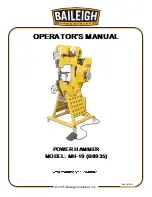
EN
51955631_ed5
EN-3
Characteristic
Test Procedure
20° F and Below
(-7° C and Below)
20° to 90° F
(-7° to 32° C)
Above 90° F
(Above 32° C)
Viscosity:
Falex Load Test lbs. (kg) [Min.]
ASTM-D2670
2000 lbs. (907 kg)
2000 lbs. (907 kg)
2000 lbs. (907 kg)
Timken E. P. Test lbs. (kg) [Min.]
ASTM-D2782
30 lbs. (14 kg)
30 lbs. (14 kg)
30 lbs. (14 kg)
Selection Chart
Typical Operating Conditions
20° to 90° F
(-7° to 32° C)
Above 90° F
(Above 32° C)
90-100 psi (6.2 to 6.9 bar)
Light
Medium
Ingersoll Rand Rock Drill Oil Part Numbers
Grade
1 Gallon (3.8 Liter)
5 Gallon (18.9 Liter)
55 Gallon (208 Liter)
Light
51378701
51378727
51378743
Medium
51378693
51378719
51378735
Heavy
51378784
51378792
51378800
Before Operation
a. Fill the oil reservoir with rock drill oil conforming to the physical and chemical properties listed in Rock Drill Oil Specifications Table .
b. Blow out the main air supply hose to get rid of moisture, rubber particles, and dirt.
c. When using new air hose, blow lubricated air through the hose to completely coat the inside with oil. This may take 10 to 15 minutes.
WARNING
Compressed air is dangerous. When blowing out an air hose, hold it firmly, and point it away from personnel and equipment. Never
blow your clothes free of dust with compressed air.
d. An air line filter can be installed in the main air supply line to keep dirt from entering the paving breaker. Air line filters are an accessory
item and must be specially ordered.
e. Connect the leader hose to the air connection on the paving breaker.
WARNING
Be sure all hose connections are tight. A loose hose not only causes leaks, but can come completely off the paving Breaker, whip
around, and injure personnel in the area. Attach safety cables to all hoses to prevent injury if a hose is accidentally broken.
f. Open the latch by pushing the lever down.
g. Insert the shank end of the paving breaker tool in the fronthead, and swing the latch up to lock the tool in the paving breaker.
CAUTION
Make sure the tool is the correct hex. size for the fronthead. Don’t use a paving breaker tool that is dull; it won’t do an effective job and
will cause unnecessary wear to the breaker.
Controls
The paving breaker is controlled by a self closing, lever operated, throttle valve that is built into the handle. When air pressure is directed to the
paving breaker, the throttle lever will be in the raised, or off, position. The paving breaker will not start until the lever is depressed. The lever
will return to the off position when it is released.
Operation
DANGER
Know what is underneath the material you are about to break. Be alert for any existing water, gas, electricity, sewer, or telephone lines.
Always keep both hands on the handle while operating the paving breaker.
The operator must keep his legs and feet clear of the paving breaker tool to prevent injury if the tool breaks. When a tool breaks, the
paving breaker (with a piece of broken tool projecting from the fronthead) will suddenly drop to the ground.
The operator will be seriously injured if the tool breaks while he is riding the paving breaker with one leg over the Handle.
CAUTION
Do not operate the paving breaker without a paving breaker tool in the anvil bushing. Hold the tool firmly against the work.
1. Grip the paving breaker handle with both hands. Depress the throttle lever with the palm of the hand, and apply firm steady pressure to
the handles. The correct amount of pressure for maximum efficiency can be gained only by experience, but generally the correct pressure is
usually recognizable by the rhythmic sound of the exhaust and maximum breaking action. Insufficient pressure will slow down the paving
breaker action. Do not “ride” the paving breaker with one leg over the handle.
•
•
•
•
•
•
Summary of Contents for MX60
Page 23: ...Notes ...
Page 24: ...ingersollrandproducts com 2014 Ingersoll Rand ...






































